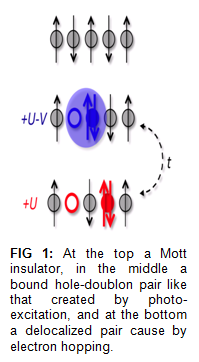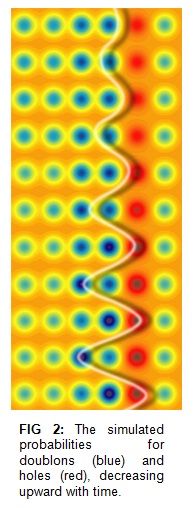Probing the quantum dynamics of electrons in a solid state room-temperature Mott insulator.
The competition between electron localization and de-localization in Mott insulators underpins the physics of strongly-correlated electron systems. In Mott insulators, conductivity at low energies is prevented by the substantial Coulomb repulsion between electrons. The state of such materials is fundamentally different from that of conventional band insulators, in which Bragg scattering from the lattice opens a gap in the single-particle density of states. In contrast charges are localized to each lattice site within Mott insulating materials, as shown in Fig 1, due to the strong electron-electron interactions compared to the kinetic energy of the electrons. For this reason the formation of a Mott insulator and its associated energy gap is an intrinsically many-body effect.
 The electronic structure of a Mott insulator is highly sensitive to doping, specifically the addition or removal of a single electron to the commensurately filled system. An increasingly popular way to probe Mott insulators is via photo-excitation. In analogy with static doping, photo-excitation by a laser pulse redistributes the charges by exciting them over the Mott gap and can be viewed as a "photo-doping" process. In doing so a situation is created, shown in Fig 1, where one lattice site is missing an electron, forming a so-called "hole", while a neighbouring site has two-electrons on it, forming a so-called "doublon". By doping the system with these excitations we see the metallization of a Mott insulator transforming it into a complicated non-equilibrium conductor for a short time. The underlying quantum dynamics of these 'bare' electronic excitations had, until now, remained out of reach in these types of materials because there were no sources of ultra-short light pulses with the frequency needed to elucidate these events on the required sub 10 femtosecond timescale.
The electronic structure of a Mott insulator is highly sensitive to doping, specifically the addition or removal of a single electron to the commensurately filled system. An increasingly popular way to probe Mott insulators is via photo-excitation. In analogy with static doping, photo-excitation by a laser pulse redistributes the charges by exciting them over the Mott gap and can be viewed as a "photo-doping" process. In doing so a situation is created, shown in Fig 1, where one lattice site is missing an electron, forming a so-called "hole", while a neighbouring site has two-electrons on it, forming a so-called "doublon". By doping the system with these excitations we see the metallization of a Mott insulator transforming it into a complicated non-equilibrium conductor for a short time. The underlying quantum dynamics of these 'bare' electronic excitations had, until now, remained out of reach in these types of materials because there were no sources of ultra-short light pulses with the frequency needed to elucidate these events on the required sub 10 femtosecond timescale.
To overcome this problem two key features underpinned the experiment modelled by Clark and Jaksch and analysed together with their colleagues. Firstly, it was performed on a stacked-molecular organic salt ET-F2TCNQ, which forms a prototypical Mott insulator at room temperature. This material is quasi-one-dimensional, giving it a simple chain geometry, and also possesses weak electron-phonon interactions, making it reasonable to model it with a standard Hubbard Hamiltonian. Secondly, experimentalists at Hamburg and Oxford constructed a novel optical device which was able to produce ultra-short pulses of laser light capable of exciting electrons with sufficient energy to overcome the Mott gap of this material. The experimental results then revealed behaviour of the frequency-dependent conductivity over an incredibly fast femtosecond timescale. In particular they showed that after photo-excitation the conductivity oscillates on a timescale of 10’s of femtoseconds before relaxing back to its static response.
 Theory work modelling the fast coherent processes revealed that this oscillatory behaviour, seen over the first few femtoseconds, contained signatures of subtle many-body effects. To start with the Hubbard model used by Clark and Jaksch was only able to reproduce the static conductivity, when nothing is done to the material, once an interaction term was included, with a fitted strength, that accounted for the binding of doublons to holes. Remarkably, the period of oscillations in conductivity measured experimentally from the quantum dynamics of the photo-excited material were found to be equivalent to this binding energy. Furthermore detailed time-dependent numerical simulations using the Hubbard model, like that in Fig 2, showed the same type of conductivity oscillations. This was convincing evidence that both the model and energy scales were highly consistent despite the complex material under investigation. Analysing the model further revealed that the oscillations seen in the experiment were a result of excited electrons not having complete freedom to move and delocalize, but instead are being recurrently pulled back to the holes they were created from. The excited electrons therefore oscillate coherently, exhibiting quantum interference, between being in a freely propagating state, and being in a state where they are trapped by their hole, as shown in Fig 1. That this effect was visible in a room temperature solid state system was due to the extremely precise time-resolution of the experiment.
Theory work modelling the fast coherent processes revealed that this oscillatory behaviour, seen over the first few femtoseconds, contained signatures of subtle many-body effects. To start with the Hubbard model used by Clark and Jaksch was only able to reproduce the static conductivity, when nothing is done to the material, once an interaction term was included, with a fitted strength, that accounted for the binding of doublons to holes. Remarkably, the period of oscillations in conductivity measured experimentally from the quantum dynamics of the photo-excited material were found to be equivalent to this binding energy. Furthermore detailed time-dependent numerical simulations using the Hubbard model, like that in Fig 2, showed the same type of conductivity oscillations. This was convincing evidence that both the model and energy scales were highly consistent despite the complex material under investigation. Analysing the model further revealed that the oscillations seen in the experiment were a result of excited electrons not having complete freedom to move and delocalize, but instead are being recurrently pulled back to the holes they were created from. The excited electrons therefore oscillate coherently, exhibiting quantum interference, between being in a freely propagating state, and being in a state where they are trapped by their hole, as shown in Fig 1. That this effect was visible in a room temperature solid state system was due to the extremely precise time-resolution of the experiment.
This research has significant impact ranging from basic research to the development of future quantum technologies. First, experiments of this type provide an important glimpse into the quantum effects underlying the charge transport properties of photo-excited carriers. Gaining further understanding of the interactions between lasers and solid matter is an important step for the manipulation and control of a material's properties using light. Indeed the light induced charge delocalization occurring in photo-induced phase transitions holds the promise of entirely new classes of materials and systems exploiting quantum phenomena. This may include using a laser to coherently drive materials between metastable macroscopically different phases, into a non-equilibrium superconducting phase, or engineering organic polymers to improve the energy transport efficiency of solar cells. These fascinating possibilities rely heavily on the rich and sophisticated interplay of coherent many-body quantum dynamics, interactions and dissipation which is only now being explored.
In February 2002, support from the Agency for Science, Technology and Research (A*STAR) consolidated research efforts in the field and led to a number of faculty appointments. In 2007, the Quantum Information Technology Group was selected as the core of Singapore’s first Research Centre of Excellence leading to the foundation of CQT in December 2007.







